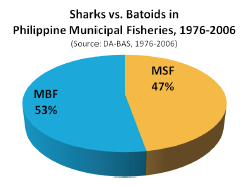Sharks in the Philipines: Shark Fishing
Stamps Howard,The Philippine elasmobranch fisheries are reported to have landed only about 300 metric tons in the 1950s. Within a 20-year period, there was a yearly catch of about 500 metric tons. After the 1970s, it was 4,821 metric tons/year. It reached a 6-year high between 1986-1991 at an average of 18,094 metric tons/year. From 1947-1991, the Philippine elasmobranch catches account for 1.44% of the worldwide elasmobranch catch and comprised only 0.8% of the total national fisheries production.
The statistics do not show segregation of specific species, just “sharks, rays, skates.” Species-specific fishery assessment is usually absent, making recommendations doubly difficult. Still, the studies show that breakdown falls roughly evenly between sharks and rays (Batoids):

Production data for landing trends of sharks and rays from 1976-2006: The trend generally increased in the first 10 and 20 years at an average rate of 10,533 metric tons/year and 14,662 metric tons/year, respectively. It declined after at a rate of 5,341 metric tons/year in the next 39 years, suggesting collapsing fisheries (p. 34).
